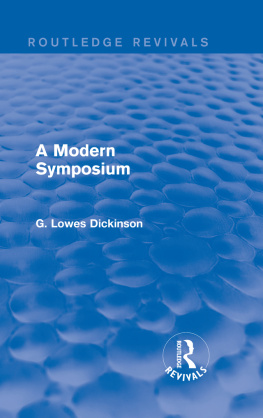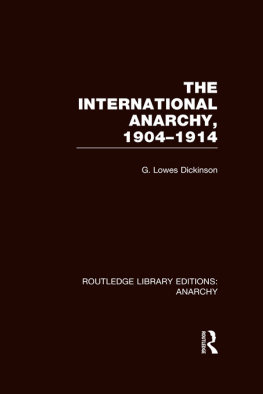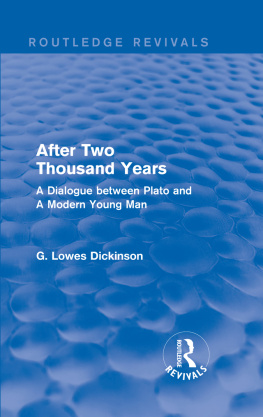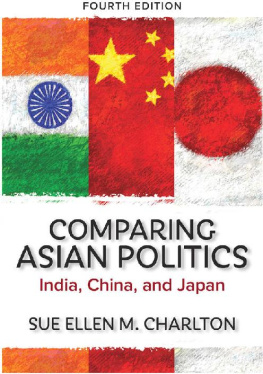ROUTLEDGE LIBRARY EDITIONS: JAPAN
AN ESSAY ON THE CIVILISATIONS OF INDIA, CHINA & JAPAN
AN ESSAY ON THE CIVILISATIONS OF INDIA, CHINA & JAPAN
G.LOWES DICKINSON
Volume 32

LONDON AND NEW YORK
First published in 1914
This edition first published in 2011
by Routledge
2 Park Square, Milton Park, Abingdon, Oxon, OX14 4RN
Simultaneously published in the USA and Canada
by Routledge
270 Madison Avenue, New York, NY 10016
Routledge is an imprint of the Taylor & Francis Group, an informa business
This edition published in the Taylor & Francis e-Library, 2010.
To purchase your own copy of this or any of Taylor & Francis or Routledges collection of thousands of eBooks please go to www.eBookstore.tandf.co.uk.
1914 G.Lowes Dickinson
All rights reserved. No part of this book may be reprinted or reproduced or
utilised in any form or by any electronic, mechanical, or other means, now
known or hereafter invented, including photocopying and recording, or in any
information storage or retrieval system, without permission in writing from the
publishers.
British Library Cataloguing in Publication Data
A catalogue record for this book is available from the British Library
ISBN 0-203-84541-2 Master e-book ISBN
ISBN 13:978-0-415-56498-4 (Set)
eISBN 13:978-0-203-84317-8 (Set)
ISBN 13:978-0-415-58533-0 (Volume 32)
eISBN 13:978-0-203-84541-7 (Volume 32)
Publishers Note
The publisher has gone to great lengths to ensure the quality of this reprint but
points out that some imperfections in the original copies may be apparent.
Disclaimer
The publisher has made every effort to trace copyright holders and would
welcome correspondence from those they have been unable to trace.
AN ESSAY ON THE CIVILISATIONS of INDIA CHINA & JAPAN
G.LOWES DICKINSON
This Essay is a Report of the authors travels as a Fellow of the Albert Kahn Travelling Fellowships and is published by direction of the Albert Kahn Trustees.
TO THE TRUSTEES OF THE ALBERT KAHN TRAVELLING FELLOWSHIPS
GENTLEMEN,
I have the honour to present the following report of my travels during the years 1912 to 1913.
Instead of describing my journey in detail I have thought it will be more interesting to offer some reflections on the general spirit and character of the civilisations of India, China, and Japan, and the apparent and probable effects upon these civilisations of contact with the West. Any conclusions one may arrive at on a subject so comprehensive are, of course, of the most tentative and hazardous kind, and what I set down here is rather the starting point than the end of an inquiry. I shall not, however, waste time and space in constantly qualifying and apologising for my statements; but say here, once for all, that everything put forward is provisional, and that any dogmatism of form is merely a concession to the requirements of brevity.
G.LOWES DICKINSON.
KINGS COLLEGE, CAMBRIDGE.
November 1913.
AN ESSAY ON THE CIVILISATIONS OF INDIA CHINA AND JAPAN
PART I.
INDIA
THE first thing I have to note is that the East is not a unity, as implied in the familiar antithesis of East and West. Between India, on the one hand, and China or Japan, on the other, there is as great a difference as between India and any western country. The contrast that has struck me is that between India and the rest of the world. There I do feel a profound gulf. A Chinese, after all, is not so unlike an Englishman, and a Japanese not so unlike a Frenchman. But a Bengalee is strangely unlike anybody outside India. While, however, the East is not a unity, the modern West is. Throughout Europe and America there is the same civilisation, intellectual and economic; so that, to a philo sophic observer, national boundaries there already begin to appear obsolete and irrelevant. On the other hand, this modern West is a very recent creation. And if one goes back in history one can find more analogy between East and West than now appears. Feudal Europe, for example, was in many respects similar to feudal Japan; and a medival Christian mystic hardly distinguishable from a contemporary Indian saint. If, therefore, we contrast East and West we shall find our contrast breaking down at every point, unless we confine the term East to India (which is absurd), and mean by the West (as of course, in fact, we do) the West of the last century only. And the contrast between that West and the West of the Middle Ages is perhaps as great as the contrast between the modern West and India. I think it best, therefore, not to attempt to characterise the East as a whole; but to deal separately with India, China, and Japan, and their reactions to the West, as they have shown themselves to me. I shall endeavour to characterise each of these civilisations, first, as they were before contact with the West; and afterwards to consider the effect upon them of that contact.
To summarise, I will say, first, that I conceive the dominant note of India to be religion; of China, humanity; of Japan, chivalry. These terms, of course, to begin with, are mere labels. I shall proceed to develop my meaning in each case.
In discussing the religion of a people one is met with the perhaps insuperable difficulty of estimating what, to the mass of the people, their religious observances really mean. I think it is clear that to the peasants of most countriesof Italy, say, or of China or of Japanreligion is no more than a ritual which they would be uncomfortable if they did not perform; a kind of lightning conductor for the emotions and desires that are concerned with the ordinary business of life, with getting ones living, with birth, marriage, child-bearing, and death. And, of course, in India religion is, at least, this. The people pray for children, pray for healing, pray for rain, pray for everything they want. But is not religion to Indians something more than this? Observers who try to know the people believe that it is, and I am inclined to think that they are
1 In speaking of Indian religion I have in view throughout Hinduism, not Mahometanism.
right; that even the Indian peasant does really believe that the true life is a spiritual life; that he respects the saint more than any other man; and that he regards the material world as unreal, and all its cares as illusion. He cannot, of course, and does not, put this conviction into practice, or Indian society would come to an end. But he admires and even worships those who do put it into practice. I have seen on the faces of poor Indians, at religious functions, an expression I have seen nowhere else, unless, perhaps, in Russian churches. At Muttra, for instance, I remember the ecstatic look on the faces of the crowd as the priests waved their torches before the image of the god; and similarly, at Kandy, the look of those who came to worship the relicsbooks even!at the Temple of the Tooth. This is idolatry, of course. But what does idolatry imply? Roman Catholics choose to think that while Christians worship the god symbolised by the image, Chinese or Indians worship the image itself. But this is sheer prejudice. And, unless I am very much mistaken, an idol is far more of a symbol and less of an object of worship to an Indian peasant than it is to most Roman Catholics. Kali is a hideous idol, fed by the blood of goats. But I am inclined to believe what I have been told, that to an Indian she symbolises the divine mother; and that it is her, not the idol, that they are worshipping.













